#Elephant Conservation
Explore tagged Tumblr posts
Text
When I'm having a bad hair day, or think I look like trash, I like to remind myself that if an elephant saw me, they would be like, "OH MY GOSH LOOK AT THAT CUTE LIL HUMAN! ITS SO TINY! LOOK AT THAT LIL FACE! LOOK AT IT! IT HAS THAT GOOFY FLUFF OF HAIR AND THAT ADORABLE LIL SQUISHY BODY! I JUST WANNA PICK IT UP AND SQUEEZE IT!" And then I feel a bit better
#elephant#elephants#cute#lil guy#lil guys#lil human#lil humans#bad hair day#trash#look like trash#elephants think we're cute#like how we see puppies#i wonder if#this makes elephants protective of us#human conservation efforts#run by elephants#elephant conservation#random stuff#random thoughts#thoughts#dumb thoughts#funny#accurate#lol#elephants are sweet#and bury their dead#save the elephants#that way they will keep making humans feel better about bad hair days#you never judge a puppy for a bad hairday#and elephants don't judge you for a bad hair day
7 notes
·
View notes
Text
Elephent Eating Watermelon
#elephant#watermelon#elephant eating watermelon#cute elephant eating watermelon#eating#elephant eating#elephant eating food#elephant eating show#baby elephant quickly grabbed watermelons to eat#elephante ating#elephant in water#elephants eating#baby elephant#asian elephant#watermelons#huge watermelon#adorable elephant#onebit watermelon#international elephant project#elephant conservation#elephants bathing#wild elephant encounter#elephant love
8 notes
·
View notes
Text

Greetings, wildlife enthusiasts!
Feast your eyes on this ethereal illustration capturing the quintessence of the majestic African elephant. Here, we see the towering matriarch guiding her calf through the sun-dappled savannah with a grace that belies her immense size. The maternal bond is almost palpable, woven with threads of wisdom and care, and radiating an aura of ancient nobility.
Notice how the artist has meticulously depicted the delicate contours and wrinkles on their expansive ears—a treasure trove of evolutionary secrets. Those ivory tusks, grand and formidable, are both a blessing and a burden in this contemporary dance of survival.
From the rhythmic cadence of their ponderous steps to the intricate markings on their skin that tell tales of a life lived under the vast African sky, this duo is a testament to resilience, strength, and the enduring spirit of nature.
This illustration is not just art; it’s a narrative, a symphony of life, shimmying silently across the canvas. Let it remind us of our duty to protect these gentle giants and their enigmatic world.
Stay wild, stay compassionate. 🌍🐘
#mother elephant#baby elephant#wildlife art#animal illustration#african wildlife#elephant conservation#nature sketch#pencil drawing#wildlife love#majestic creatures
4 notes
·
View notes
Text
Excited to unwrap one of our blanket-clad babies later, as we celebrate World Elephant Day.
Heading up the 'blanket brigade,' this little orphan's rescue has afforded him a second chance at life.
Now he needs our support on his long journey back to the wild. Stay Tuned.
🤍🐘🤍
—
History of World Elephant Day
On 12 August 2012, Patricia Sims, a Canadian, and the Elephant Reintroduction Foundation of Thailand, an initiative of HM Queen Sirikit of Thailand, co-founded World Elephant Day.
Patricia Sims has continued to oversee World Elephant Day ever since.
It has partnered with 100 elephant conservation organisations globally since its beginning and has reached countless people all over the world.
The fact that World Elephant Day has garnered millions of participants worldwide demonstrates how much people care about elephants and want to do anything they can to save them.
World Elephant Day is a day where organizations and individuals can rally together to give a voice to the issues threatening elephants.
This powerful, collective global movement offers a way to establish and endorse conservation solutions to make the world a safer place for elephants and their habitats so future generations can appreciate them.
Let’s combine all our efforts on August 12 for World Elephant Day to help preserve and safeguard elephants from the multiple threats they face.
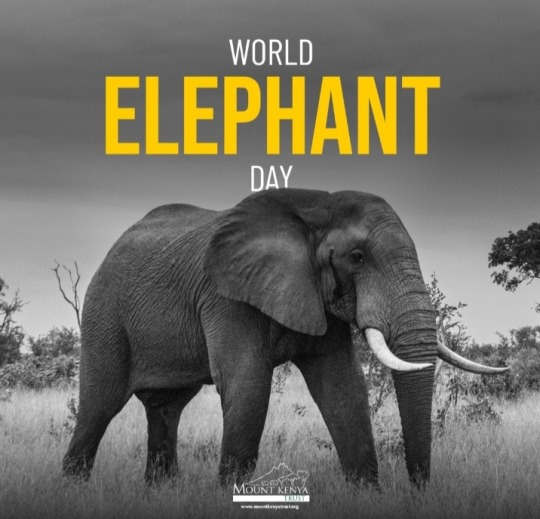

#World Elephant Day#World Elephant Day 2023#Sheldrick Wildlife Trust (SWT)#Kenya#Patricia Sims#HM Queen Sirikit of Thailand#Elephant Reintroduction Foundation of Thailand#August 12#12 August 2012#elephants#Mount Kenya Trust#STAE#Save The Asian Elephants#African elephants#Asian elephants#blanket brigade#save animals#save wildlife#elephant conservation
10 notes
·
View notes
Text
Tata Zoo Celebrates World Elephant Day with Educational Outreach
Conservation Efforts Highlighted at Jamshedpur’s Popular Wildlife Park Tata Steel Zoological Park marked World Elephant Day with engaging activities, emphasizing the importance of elephant conservation. JAMSHEDPUR – Tata Steel Zoological Park (TSZP) in Jamshedpur commemorated World Elephant Day on August 12 with educational programs aimed at raising awareness about elephant conservation. Visitors…
#आयोजन#biodiversity#Dalma Wildlife Sanctuary#elephant conservation#environmental education#Event#Jamshedpur#Tata Steel Zoological Park#wildlife awareness#World Elephant Day
0 notes
Text
World Elephant Day: Protecting and Celebrating Earth’s Gentle Giants
Celebrate World Elephant Day on August 12th by honoring these majestic creatures and taking action to protect them. Learn about the challenges elephants face and how you can make a difference. #WorldElephantDay #Conservation #SaveTheElephants
World Elephant Day, celebrated every year on August 12th, is a global event dedicated to the preservation and protection of elephants. These majestic creatures, known for their intelligence, social bonds, and critical role in ecosystems, are under threat from habitat loss, poaching, and human-wildlife conflict. World Elephant Day brings attention to the challenges elephants face and encourages…
#African Elephants#Asian Elephants#Elephant Conservation#Endangered Species#Ethical Tourism#Habitat Loss#Ivory Trade#Poaching#Wildlife Advocacy#wildlife protection#World Elephant Day
0 notes
Text

"World Elephant Day"#trending#viral
World Elephant Day Importance extends beyond a simple commemoration; it represents a global movement dedicated to the protection and preservation of one of the planet's most majestic creatures. Elephants play a vital role in maintaining the balance of our ecosystems, yet they face numerous threats, including poaching, habitat loss, and human-wildlife conflict. This explores why World Elephant Day is crucial for raising awareness and promoting conservation efforts. We delve into the challenges elephants face, the significance of their survival to biodiversity, and how each of us can contribute to their protection. Whether you are a wildlife enthusiast, conservationist, or simply someone who cares about the environment, this will inspire you to understand and appreciate the importance of World Elephant Day.
Call: 7799799221
Website: www.manasadefenceacademy.com
#WorldElephantDay#ElephantConservation#SaveElephants#WildlifeProtection#ElephantAwareness#ProtectElephants#ConservationMatters#EndangeredSpecies#SaveWildlife#ElephantDay#trending#viral#manasadefenceacademy
#World Elephant Day Importance#Elephant Conservation#Save Elephants#Wildlife Protection#Elephant Awareness#Protect Elephants#Conservation Matters#Endangered Species#Save Wildlife#Elephant Day#Wildlife Conservation#Elephant Protection#World Elephant Day#Save the Elephants#Elephant Survival#Elephant Crisis#Conservation Awareness#Elephant Habitat#Stop Poaching#Protect Wildlife#Wildlife Awareness#Elephant Ecosystem#Elephant Population#Wildlife Activism#Conservation Efforts#Elephant Rescue#Elephant Advocacy#World Wildlife#Wildlife Preservation#Elephant Endangerment
1 note
·
View note
Text


" Cheeky faces of Kruger 🐘🦒🐒"
// © Kate Newman
#Kruger National Park#South Park#nature#landscape#Portrait#Wildlife#Pachiderns#Elephants#Savanah#Safari#Grass#Wilderness#Reserve#Conservation#photography#aesthetics#wanderlust#explore#follow#discover
189 notes
·
View notes
Text
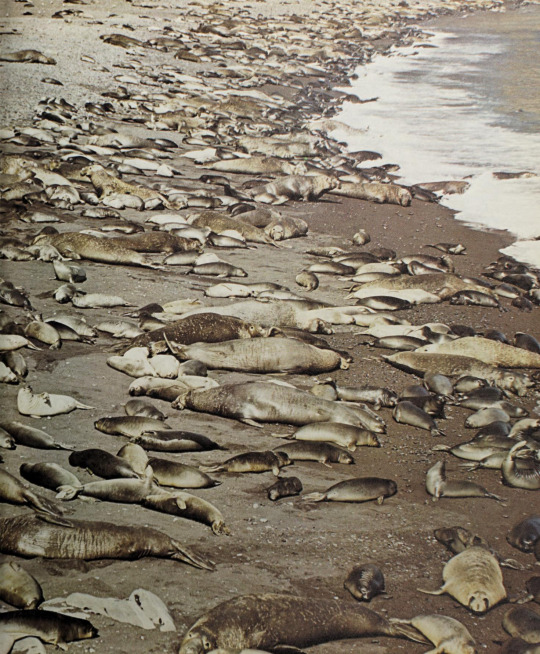
Northern elephant seals By: Sven Gillsater From: The World Conservation Yearbook 1976
154 notes
·
View notes
Text
"Nouabalé-Ndoki National Park in Brazzaville, Republic of Congo has a lot to celebrate.
The park, which celebrated its 30th anniversary on December 31 of 2023, also shared an exciting conservation milestone: 2023 was the first year without any elephant poaching detected.
“We didn’t detect any elephants killed in the Park this year, a first for the Park since [we] began collecting data. This success comes after nearly a decade of concerted efforts to protect forest elephants from armed poaching in the Park,” Ben Evans, the Park’s management unit director, said in a press release.
Nouabalé-Ndoki National Park was developed by the government of Congo in 1993 to maintain biodiversity conservation in the region, and since 2014, has been cared for through a public-private partnership between Congo’s Ministry of Forest Economy and the Wildlife Conservation Society.
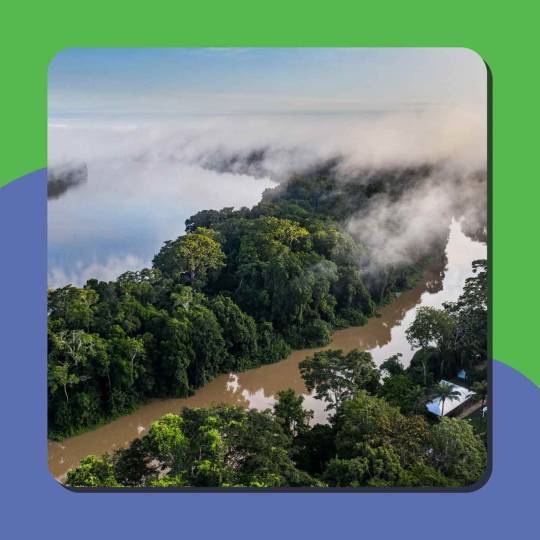
Pictured: Nouabalé-Ndoki National Park. Photo courtesy of Scott Ramsay/Wildlife Conservation Society
Evans credits the ongoing collaboration with this milestone, as the MEF and WCS have helped address escalating threats to wildlife in the region.
This specifically includes investments in the ranger force, which has increased training and self-defense capabilities, making the force more effective in upholding the law — and the rights of humans and animals.
“Thanks to the strengthening of our anti-poaching teams and new communication technologies, we have been able to reduce poaching considerably,” Max Mviri, a park warden for the Congolese government, said in a video for the Park’s anniversary.
“Today, we have more than 90 eco-guards, all of whom have received extensive training and undergo refresher courses,” Mviri continued. “What makes a difference is that 90% of our eco-guards come from villages close to the Park. This gives them extra motivation, as they are protecting their forest.”
As other threats such as logging and road infrastructure development impact the area’s wildlife, the Park’s partnerships with local communities and Indigenous populations in the neighboring villages of Bomassa and Makao are increasingly vital.
“We’ve seen great changes, great progress. We’ve seen the abundance of elephants, large mammals in the village,” Gabriel Mobolambi, chief of Bomassa village, said in the same video. “And also on our side, we benefit from conservation.”
Coinciding with the Park’s anniversary is the roll-out of a tourism-focused website, aiming to generate 15% of its revenue from visitors, which contributes significantly to the local economy...
Nouabalé-Ndoki also recently became the world’s first certified Gorilla Friendly National Park, ensuring best practices are in place for all gorilla-related operations, from tourism to research.
But gorillas and elephants — of which there are over 2,000 and 3,000, respectively — aren’t the only species visitors can admire in the 4,334-square-kilometer protected area.
The Park is also home to large populations of mammals such as chimpanzees and bongos, as well as a diverse range of reptiles, birds, and insects. For the flora fans, Nouabalé-Ndoki also boasts a century-old mahogany tree, and a massive forest of large-diameter trees.
Beyond the beauty of the Park, these tourism opportunities pave the way for major developments for local communities.
“The Park has created long-term jobs, which are rare in the region, and has brought substantial benefits to neighboring communities. Tourism is also emerging as a promising avenue for economic growth,” Mobolambi, the chief of Bomassa village, said in a press release.
The Park and its partners also work to provide education, health centers, agricultural opportunities, and access to clean water, as well, helping to create a safe environment for the people who share the land with these protected animals.
In fact, the Makao and Bomassa health centers receive up to 250 patients a month, and Nouabalé-Ndoki provides continuous access to primary education for nearly 300 students in neighboring villages.
It is this intersectional approach that maintains a mutual respect between humans and wildlife and encourages the investment in conservation programs, which lead to successes like 2023’s poaching-free milestone...
Evans, of the Park’s management, added in the anniversary video: “Thanks to the trust that has been built up between all those involved in conservation, we know that Nouabalé-Ndoki will remain a crucial refuge for wildlife for the generations to come.”"
-via Good Good Good, February 15, 2024
#conservation#congo#republic of congo#elephant#gorilla#endangered species#biodiversity#conservation news#conservation efforts#indigenous communities#national park#protected areas#poaching#elephant poaching#ecology#biology#environment#environmental news#forests
1K notes
·
View notes
Text
Dandelion News - November 1-7
Like these weekly compilations? Tip me at $kaybarr1735 or check out my Dandelion Doodles on Patreon!
1. Climate Initiatives Fare Well Across the Country Despite National Political Climate

“[California voters approved] a $10 billion bond measure to boost climate resilience across [the] state[…. Hawai’i] voters cast their ballots in favor of establishing the [climate] resiliency fund, with money for the project coming from existing property tax revenue.“
2. ‘You have to disguise your human form’: how sea eagles are being returned to Severn estuary after 150 years

“[… To avoid imprinting,] the handlers will wear long robes and feed the young eagles chopped rabbit and other meat with bird hand-puppets. […] Williams hopes that restoring eagles to the top of the food chain in the estuary will create a more balanced, thriving ecosystem.”
3. 10 states voted on pro-abortion referendums. 7 of them passed

“New York voters overwhelmingly approved the Equal Rights Amendment, adding [… among other characteristics] gender expression, pregnancy, and pregnancy outcomes to anti-discrimination laws. […] In deep-red Missouri and Montana, voters also enshrined abortions protections in their state constitutions.”
4. Giant rats could soon fight illegal wildlife trade by sniffing out elephant tusk and rhino horn

“”Our study shows that we can train African giant pouched rats to detect illegally trafficked wildlife, even when it has been concealed among other substances[.…] They can easily access tight spaces like cargo in packed shipping containers or be lifted up high to screen the ventilation systems of sealed containers,” Szott explained.”
5. Sarah McBride wins Delaware U.S. House seat, becoming the first out trans member of Congress

“McBride spearheaded Delaware’s legislation to ban the “gay and trans panic” defense as a state senator [… and] helped to pass paid family and medical leave, gun safety measures, and protections for reproductive rights.”
6. Critically endangered Sumatran elephant calf born in Indonesia

“Indonesian officials hailed the births and said they showed conservation efforts were essential to prevent the protected species from extinction. […] Sumatran elephants are on the brink of extinction with only about 2,400-2,800 left in the world, according to the World Wide Fund for Nature.”
7. Sin City is Going Green

“[Hotels there] have conserved 16 billion gallons of water since 2007, thanks to […] replacing grass with desert-friendly landscaping, installing water-efficient taps across all properties, and reusing water at aquariums and in the Bellagio Fountain.”
8. Gray squirrel control: Study shows promise for effective contraceptive delivery system

“[… T]he feeders have a very high level of species-specificity. […] The bait and monitoring system developed and tested in the study demonstrated that […] “spring was the only season tested where female squirrels were more likely to visit bait feeders than males. Spring coincides with a peak in squirrel breeding and is therefore a good time to deliver a contraceptive."”
9. Returning Grazing Land to Native Forests Would Yield Big Climate Benefits

“[… S]trategically regrowing forests on land where cattle currently graze […] while intensifying production elsewhere could drastically cut greenhouse gas emissions, with little hit to global protein production, a new study shows.”
10. Interior Department Strengthens Conservation of American Bison Through New Agreement with Canada and Mexico

“Approximately 31,000 bison are currently being stewarded by the United States, Canada and Mexico with the goal of conserving the species and their role in the function of native grassland systems, as well as their place in Indigenous culture.”
October 22-28 news here | (all credit for images and written material can be found at the source linked; I don’t claim credit for anything but curating.)
#hopepunk#good news#voting#climate#climate change#eagles#abortion rights#abortion#rats#giant rat#sarah mcbride#congress#trans rights#transgender#elephant#endangered species#las vegas nevada#water conservation#squirrel#cattle#livestock#bison#canada#mexico#indonesia#nature#us politics#animals#sin city#missouri
281 notes
·
View notes
Text

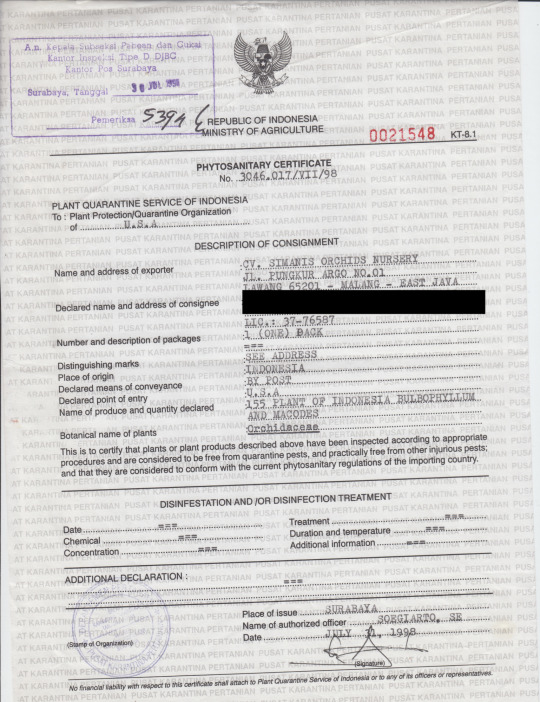
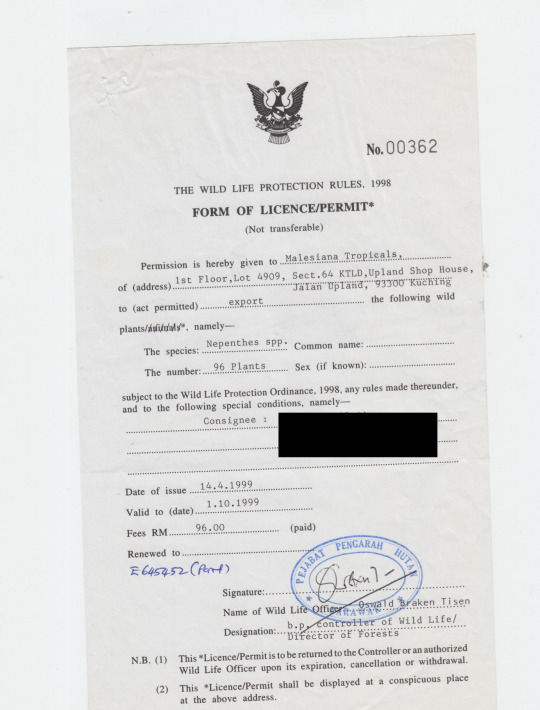

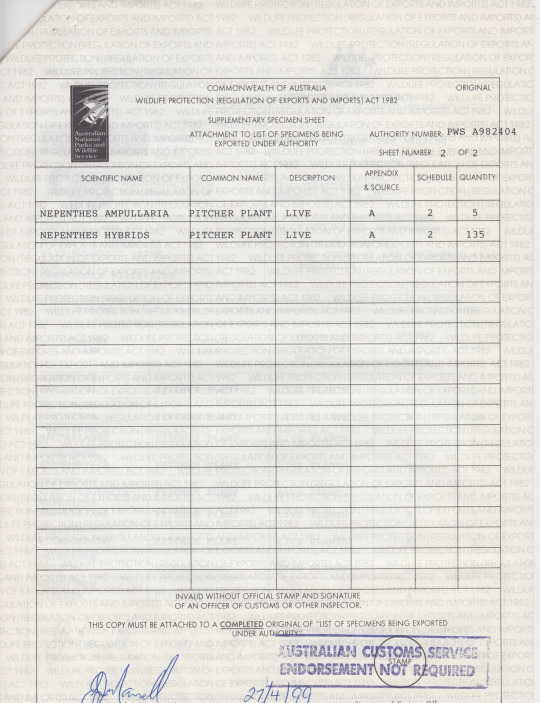
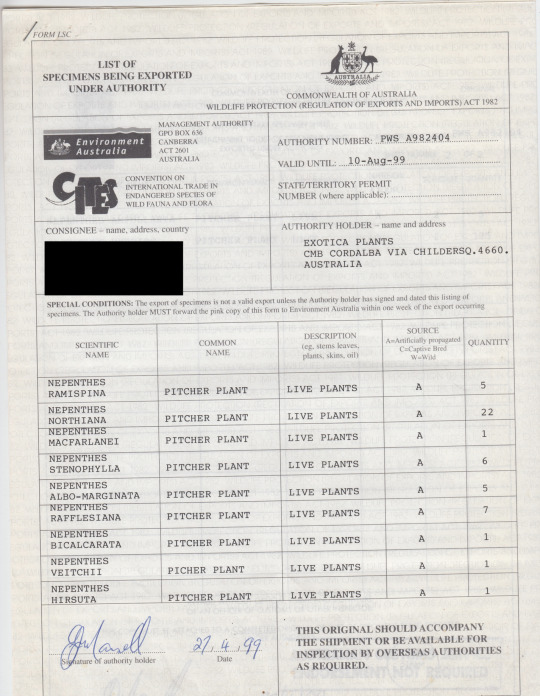
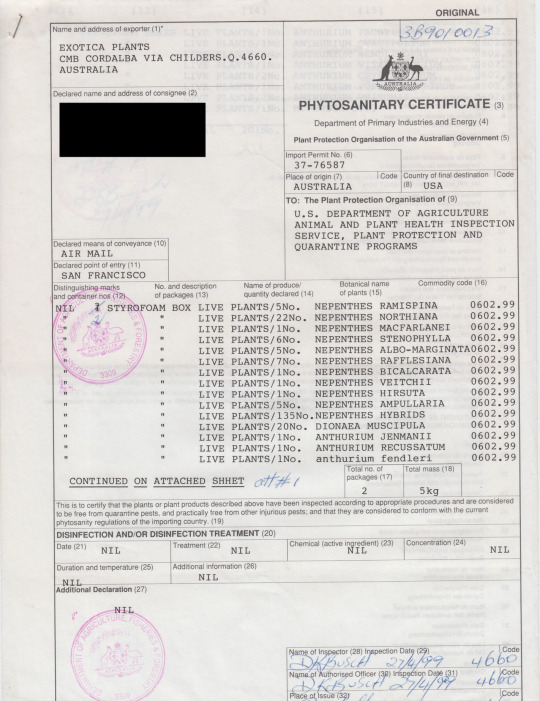
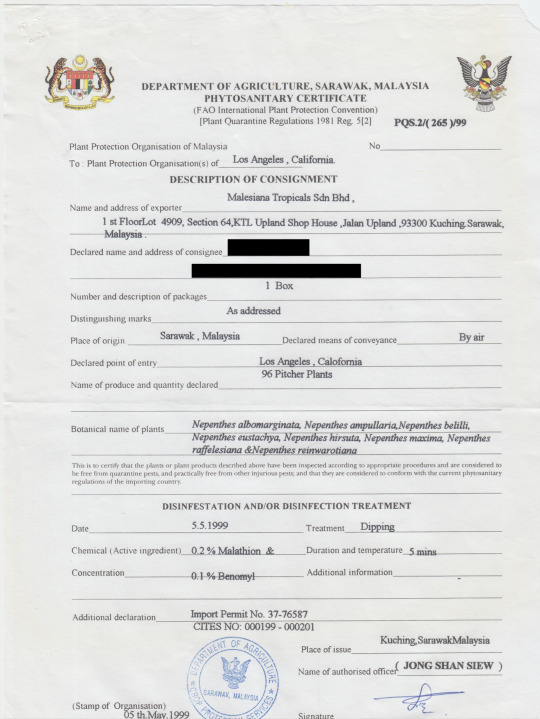
ok INCREDIBLY old content originally meant for this blog but in 2018 when i was just a wee lad with a little spinner propeller hat and big rainbow lollipop i went to a carnivorous plant convention in california and met a bunch of people who breed/collect/study these guys. one person was this collector who was slowly working on leaving the hobby or at least no longer growing plants, and he had a bunch of carnivorous plant related files he was charging like 50 cents for or something, and so i came into possession of these, which are examples of the kind of paperwork you have to have done to legally ship/trade endangered species of both plants and animals. functionally very boring paperwork, but something i found like, incredibly fascinating. i blacked out the personal id of the person and then immediately forgot to ever upload them, lmao.
these plants were bred and raised in a greenhouse and sold abroad, not taken from the wild, but because the species are endangered and often protected in their native countries (most of these are nepenthes, asian pitcher plants, a huge family spread throughout oceania and southeast asia), there's a lot more documentation that needs to be done regardless of their origin, both on the end of the seller and on the end of the buyer.
the rabbit hole on carnivorous plant trade is deep and kind of wild. there's plenty of common, non-threatened, greenhouse-grown pitcher plants on the market that people buy all the time, even non-collectors, but there's a whole debate to be had on if it's morally okay to be collecting the more endangered/rare of these plants in the first place. the big argument for breeding is that breeding them in captivity means there's more supply that's not poached from the wild, meaning poachers have less of an incentive to take the risk of taking adult plants from their habitats; from what i've heard, sometimes countries will issue permits for breeders to collect some wild seeds just to create a non-wild breeding pool to drive down the price. predictably, however, you also get people who are very much willing to pay a lot of money to get as rare of a plant as possible.
anyone familiar with the allure valuable plants have had over people throughout history can imagine the rest, but here's an article about a guy who started buying poached plants to enrich his private nepenthes collection, who then got busted by a fish and wildlife service agent embedded in his carvirorous plant circle. the plants this guy was buying were being sold to him without any CITES paperwork or declarations like the ones above; it was literally just a guy in indonesia taking rare plants from the woods around where he lived, selling them over facebook marketplace and ebay, and mailing them overseas as an undeclared 'gift' to get around customs. frighteningly small steps to take on all sides, to be honest.
(also, fun fact: another example of carnivorous plants that get poached are wild venus fly traps, which are only native to north and south carolina in the US. from what i understand it's a mix of people who genuinely did not know it's a native species and people who really are just going out into the woods and digging up plants to sell online. sometimes poaching is closer to home than you'd think!)
anyway. wild and interesting times in the land of plants recovered from a hard drive lmao
#nepenthes#annual 'plant poaching happens and it doesnt always look like the movies' post i suppose but also i think its really interesting#also the CITES system could do with an overhaul in how it approaches plants as well from what i understand but thats another thing#ive heard that like many systems like this they do not have the same urgency for plants as they do for animals#mostly because people just!! they dont get plants man!! they just say whatever its a plant!!#and poaching in general is only ever talked about like its with taking elephants for their tusks and stuff#also important conservation work but sometimes poaching really is just a guy with a shovel and that shit is WILD#carnivorous plants
525 notes
·
View notes
Text
As a helicopter hovers close to an elephant, trying to be as steady as possible, an experienced veterinarian cautiously takes aim. A tranquilizer dart whooshes in the air, and within minutes the giant mammal surrenders to a deep slumber as teams of wildlife experts rush to measure its vitals and ensure it’s doing ok. Kenya is suffering from a problem, albeit a good one: the elephant population in the 42-square-kilometer (16-square-mile) Mwea National Reserve, east of the capital Nairobi, has flourished from its maximum capacity of 50 to a whopping 156, overwhelming the ecosystem and requiring the relocation of about 100 of the largest land animals. It hosted 49 elephants in 1979. According to the Kenya Wildlife Service Director General Erustus Kanga, the overpopulation in Mwea highlighted the success of conservation effort s over the last three decades. “This shows that poaching has been low and the elephants have been able to thrive,” Kanga said. Experts started relocating 50 elephants last week to the expansive 780-square-kilometer (301-square-mile) Aberdare National Park in central Kenya. As of Monday, 44 elephants had been moved from Mwea to Aberdare, with six others scheduled for Tuesday.
156 notes
·
View notes
Text
A genetic study of Asian elephants in northern Cambodia published Thursday reveals a larger and more robust population than previously thought, raising hopes the endangered species could slowly recover. Researchers from the Fauna & Flora conservation group collected samples from elephant dung in Cambodia's northern plains and extracted DNA. From the DNA they were able to identify individual elephants, estimate population size, and determine the sex of the animals and the overall genetic diversity of the population.
Continue Reading.
77 notes
·
View notes
Text
Chakulia Hosts Massive Tree Plantation Drive on World Elephant Day
Aiming to plant 100,000 trees, Jharkhand’s Forest Department marks World Elephant Day with a large-scale tree plantation drive in Chakulia. Jharkhand’s Forest Department organized a tree plantation event in Chakulia on World Elephant Day, targeting the planting of 100,000 trees to support forest and elephant conservation. JAMSHEDPUR – On World Elephant Day, the Jharkhand government, through the…
#जनजीवन#Chakulia environmental event#DFO Saba Alam#elephant conservation#forest conservation#Jamshedpur Environmental News#Jharkhand forest department#Jharkhand tree plantation#Life#rural community involvement#Samir Kumar Mohanty#World Elephant Day
0 notes
Text





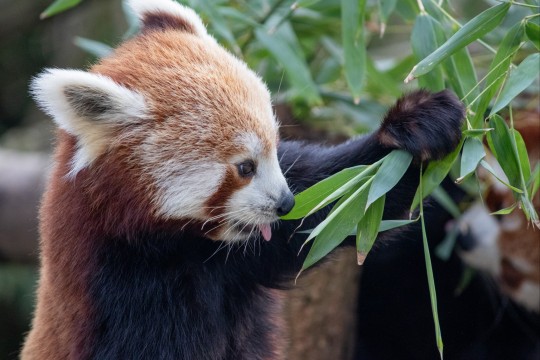

Red Pandas, from Blackpool Zoo
#Ive not been to the zoo in years#And its interesting going in as an adult#Zoo enclosures just don't seem big enough#Some animals like the elephants and wolves can have territories spanning miles in the wild#And to see them cooped up is really sad#I think zoos can do great conservation work but sometimes i wonder if its worth it to keep the animals in small enclosures like they do#The outdoor elephant enclosure at Blackpool Zoo is 0.8 hectares.#Experts recommend at least 100 hectares for elephants to live a happy life#red panda#panda#blackpool zoo#zoo#photography#canon 7d mark ii#7d mark ii#canon camera#wildlife photography#nature#nature photography#cute
56 notes
·
View notes